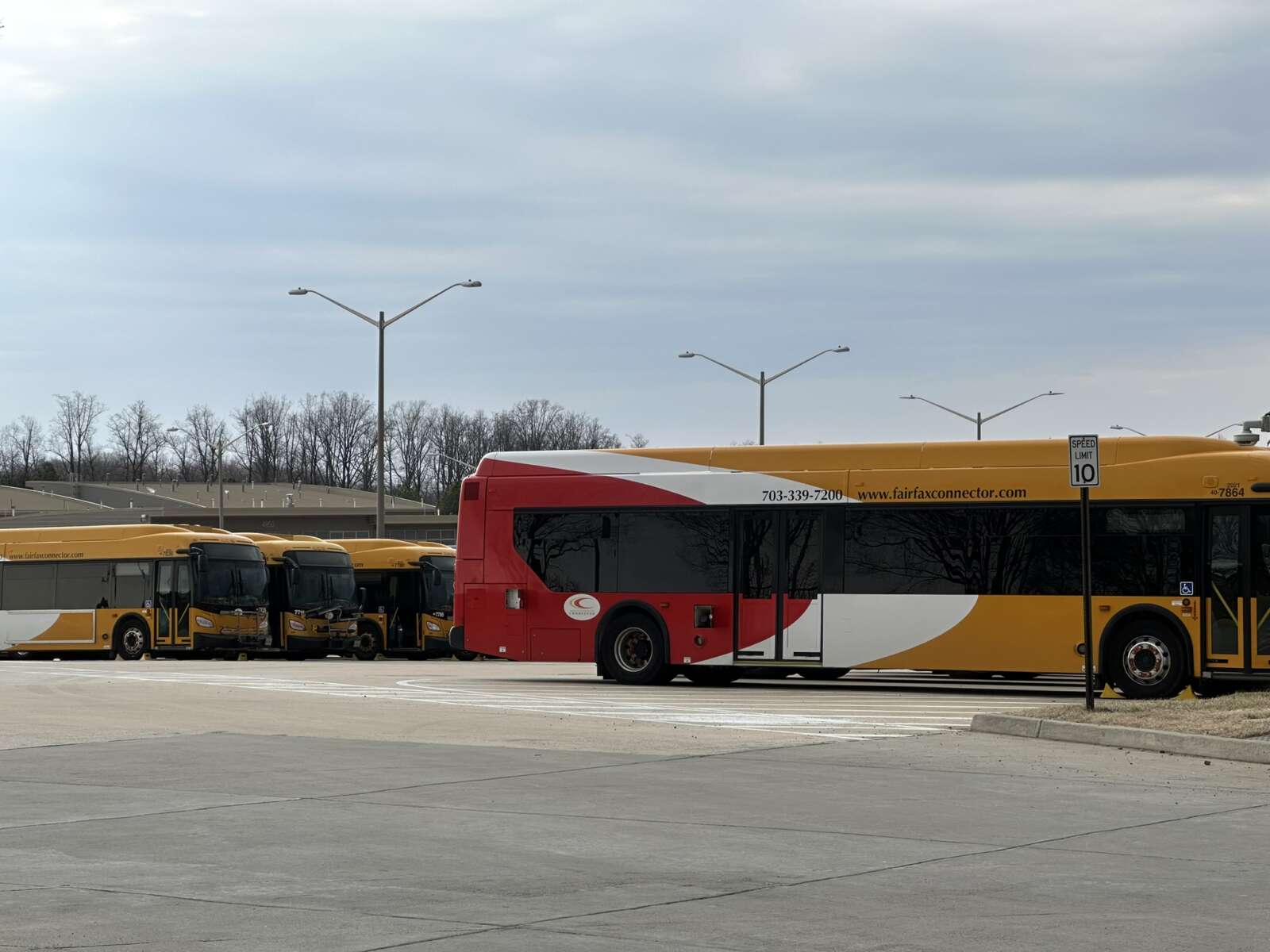
(Updated at 10:30 a.m.) Fairfax Connector is now in its sixth consecutive day without service, as workers continue their strike for better pay, benefits and working conditions.
More than 600 bus drivers and mechanics ceased working last Thursday (Feb. 22) when their union — Amalgamated Transit Union (ATU) Local 689 — called for a strike after months of negotiations with Transdev, the private company that operates Fairfax Connector, for a new labor contract to replace one that expired on Nov. 30.
In a press release, the union said yesterday (Monday) that it met with Transdev but didn’t reach an agreement, stating that the company “failed to offer an acceptable deal,” particularly when it comes to retirement contributions.
The Fairfax County Department of Transportation has said Northern Virginia’s largest public bus system can’t resume service until the strike ends, forcing the Connector’s approximately 26,000 daily riders to find alternate travel options. The county has suggested teleworking, carpooling, walking, bicycling or using other transit, such as Metro and Virginia Railway Express (VRE).
County data indicates that most commuters drive to work, as public transportation usage fell during the COVID-19 pandemic, from 10% in 2019 to 5% in 2022. However, Fairfax Connector’s ridership appears to have bounced back last year, exceeding 2019 levels with 774,875 passengers as of June, according to the Northern Virginia Regional Commission’s transit data dashboard.
In addition to workers, the Connector provides a crucial travel option for many students, who can get a free pass if they’re in middle or high school that can also be used for Fairfax City’s CUE bus and, for select schools, Metrobus.
According to ATU Local 689, the next bargaining session isn’t scheduled until March 5, when federal mediators are expected to attend. This strike has already surpassed the last Connector work stoppage, which lasted four days in 2019.
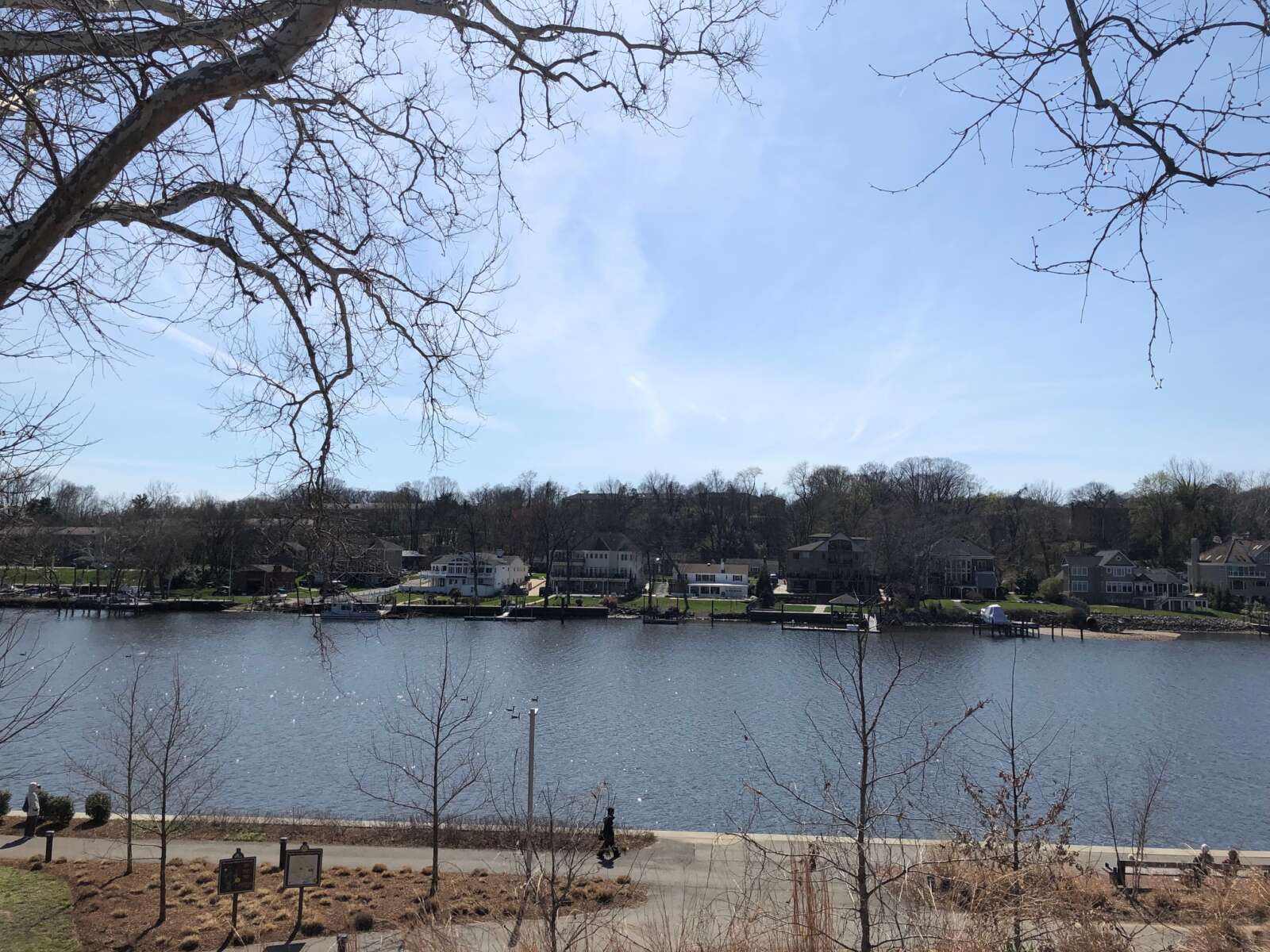
A proposed commuter ferry system for the Potomac River in Northern Virginia has gained attention from regional officials, but the price tag has dampened enthusiasm.
With budget shortfalls looming and a projected recession ahead, local and state leaders have turned their attention elsewhere, leaving it to the private sector to consider investing in the costly project.
“There’s not a lot of money on the public sector side available to make these substantial investments in equipment and places for the boats to dock,” said Robert Lazaro, executive director for the Northern Virginia Regional Commission, which recently received the latest report on the commuter ferry idea. “It’s a doable project, but it’s going to require private sector involvement.”
Since the early 2000s, leaders in Northern Virginia and the rest of the Washington metropolitan area have sought alternative transportation options to address ever-growing road congestion and conducted multiple studies. One idea was to operate a ferry along the Potomac River between Virginia and Maryland, south of Washington, D.C.
More than 200 people and groups spanning the government, military, higher education and private industry sectors have studied the idea.
The proposal isn’t unprecedented for a public service. Virginia operates three ferry systems, of which the largest is the Jamestown-Scotland Ferry that runs from Jamestown in James City County to Surry County.
In 2018, the Potomac and Rappahannock Transportation Commission, which also operates bus system OmniRide, was close to launching a pilot that would run two daily boats on the Potomac, but plans were derailed when the Virginia Department of Transportation and NRVC failed to qualify for a necessary federal grant, InsideNoVa reported last year.
On Sept. 28, the Northern Virginia Regional Commission received the latest report on the commuter ferry proposal from Nelson\Nygaard Consulting Associates.
Cost
Planners outlined four possible routes along which the commuter ferry could operate. Two of the four would originate in Woodbridge, with one route terminating at Joint Base Anacostia Bolling and the other going to Southeast and Southwest Waterfront in Washington, D.C. A third route branded the DC River Circulator would run from Georgetown to Poplar Point, and the fourth would go from Charles County, Maryland to Joint Base Anacostia Bolling.
Project costs for the Virginia route to Joint Base Anacostia Bolling range from $23.5 million to $53.5 million depending on the type of vessel, necessary terminal upgrades and dredging needs. Fare prices are proposed to be $10.
“I think over time some of this will happen, maybe not in my lifetime, because I think it makes a lot of sense, but not for right now,” said NVRC member Libby Garvey at the commission’s September meeting.
Payne said the project will likely be tabled indefinitely until another group takes over.
“There is great hope that there is project leadership who is going to step up and carry this project forward, but how that happens remains to be seen,” Payne said. Read More

Fairfax Connector’s operator and workers remain far apart in their negotiations for a new labor contract, says the union representing drivers and other employees of Northern Virginia’s largest public bus system.
Amalgamated Transit Union (ATU) Local 689 accused contractor Transdev of “clearly not [being] serious about bargaining in good faith” in a strongly worded statement issued last Wednesday (Nov. 22), just before Thanksgiving.
Representing 546 employees of Fairfax Connector, which serves about 26,000 daily passengers across 93 different routes, the union confirmed that it got Transdev’s latest contract offer a day earlier. Exact details of the proposal weren’t shared, but the union says workers would still be paid “well below other transit workers” in the D.C. area.
“Transdev’s latest wage offer was a slap in the face since its insulting lowball offer is contingent on the Union withdrawing all of its other economic proposals which include better sick leave, reduced healthcare costs, and retirement security,” ATU Local 689 said in its statement.
The union also claimed that Transdev has “continuously dragged their feet” when responding to requests for meeting dates since the collective bargaining process began in October.
Transdev, a French company that took over Fairfax Connector’s operations and maintenance in 2019, disputed the union’s characterization of the ongoing contract talks, stating that it’s “committed to continuing negotiations in good faith.”
“We value our partnership with the ATU and remain hopeful that we can come to a mutually-agreeable resolution quickly,” a Transdev spokesperson said by email. “We have mutually agreed with ATU to schedule our next bargaining session on 12/1.”
The Dec. 1 bargaining session will come after the existing, five-year contract expires on Nov. 30 at 11:59 p.m.
According to Local 689 spokesperson Ben Lynn, both sides will continue to operate under the current contract even after it expires. Determining worker pay, benefits, working conditions and other issues, the contract was secured in early 2020 after a four-day strike upended bus service throughout the county.
The union could call for a strike authorization vote at any time, but Lynn says nothing has been scheduled so far.
Transdev says it doesn’t anticipate any service disruptions as a result of the agreement expiring.
In its statement, ATU Local 689 said it has “reached tentative agreements on a variety of issues,” but on several of its top concerns, which include wage increases, improved sick leave, retirement security and standardized schedules, the union has been met with “abysmally low numbers” or outright rejection.
“Local 689 members worked on the front line throughout the pandemic to move thousands of people every day across the region,” the union said. “Transdev’s employees deserve to have their dedication and hardwork respected by the company. They have refused to offer a realistic economic proposal that would account for the intense economic pressures impacting its employees over the past three years while continuing to profit off the backs of their workers.”
Fairfax Connector’s labor negotiations come at a challenging time for public transit in the D.C. area, as Metro faces a potential $750 million budget gap and declining fare revenue even as ridership starts to bounce back after the COVID-19 pandemic.
Without significant additional funding, the Washington Metropolitan Area Transit Authority said in October that it could be forced to drastically reduce rail and bus service starting July 2024, raise fares and lay off up to 4,700 workers.
ATU Local 689, which also represents Metro workers, warned WMATA against “balancing Metro’s budget on the backs of workers,” arguing that cutting service levels and worker compensation “simply will not solve the systemic funding issues plaguing” the transit agency.
According to Axios DC, Metro General Manager and CEO Randy Clarke will present an official budget proposal to the agency’s board of directors on Dec. 14.
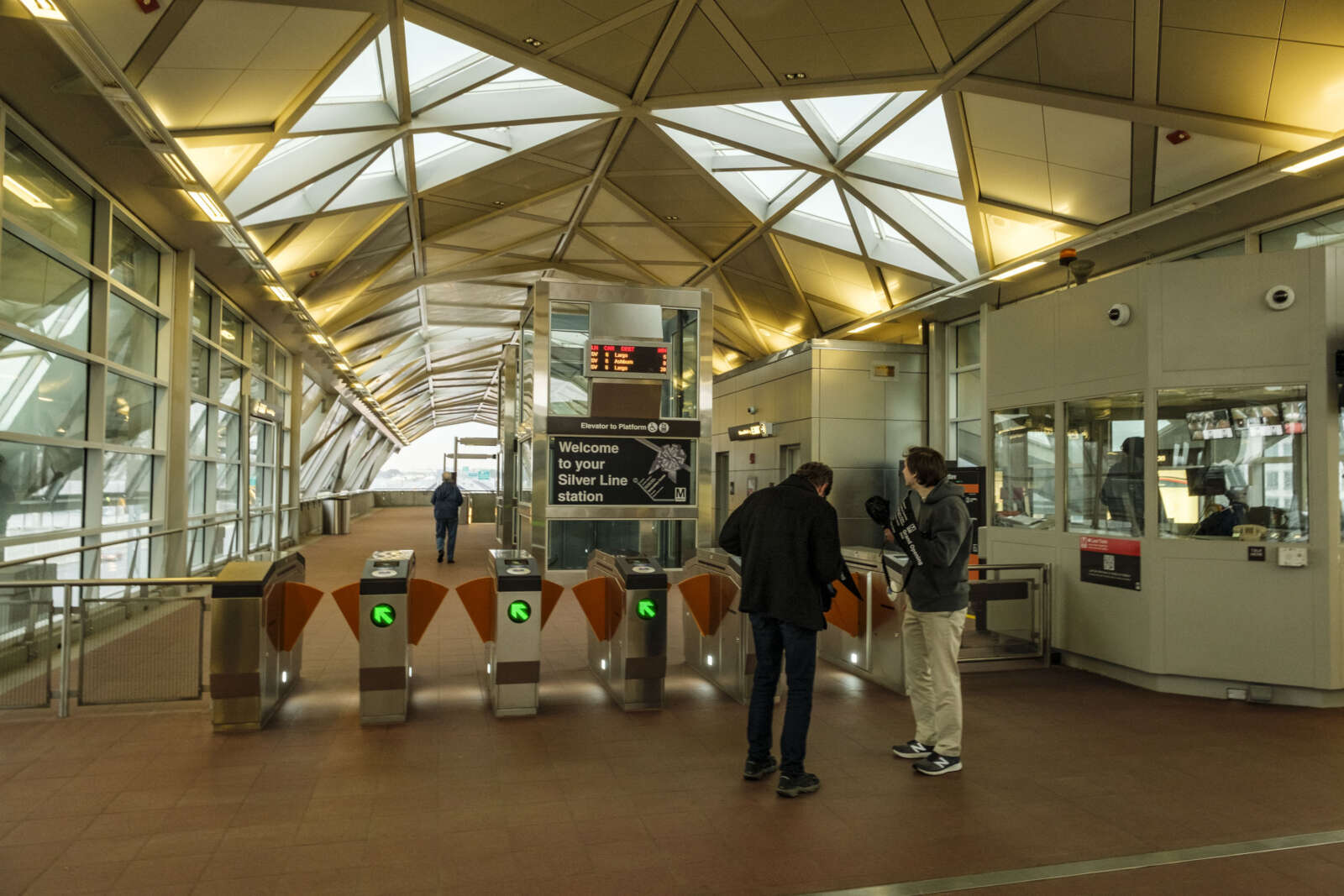
(Updated at noon) Trains are taking off at the Dulles Airport Metro station one year after the opening of Phase Two of the Silver Line — but ridership at the other five stations of the $3 million project has a long way to catch up.
In the backdrop of post-pandemic recovery, ridership for stations beyond the airport is modest, according to Metro data.
More than 3.5 million trips later, daily average ridership on the rail extension hovers at 3,600 trips. Metropolitan Washington Airport Authority (MWAA) planners had hoped for 20,000 riders a day when the rail line was being planned in the early 2000s.
But that was well before the pandemic upended how people work and travel, among other societal trends.
Jordan Pascale, a spokesperson for the Washington Metropolitan Area Transit Authority (WMATA), emphasized that “many factors have changed since then,” especially the massive shift to telework that has contributed to reduced revenue and a $750 million budget shortfall.
As more companies usher — and, in some cases, threaten — their employees to return to long-empty offices, Pascale notes that the Metro system has recovered more than half of the riders it lost at the onset of the pandemic.
“Our ridership has continually increased, but recovered unevenly with strong ridership on weekends, Tuesdays, Wednesdays, and Thursdays,” Pascale said.
One year ago today, the long-anticipated Silver Line Extension opened six new stations in Northern Virginia. They've now seen 3.5 million trips!
The extension took a lot of work, and I'm thrilled to see so many Virginians making good use of it every single day. https://t.co/FWFdfaDU1p
— Rep. Gerry Connolly (@GerryConnolly) November 15, 2023
While Dulles Airport boasts more than 1.2 million cumulative entries, the stations in Herndon and Reston hover in the mid-to-high 400,000s.
Herndon has had more than 482,000 entries since service began last November, compared to 431,000 at Innovation Center and 450,356 at Reston Town Center. Ashburn has the second highest ridership figures (774,000), while Loudoun Gateway — which is on the west end of the rail — stood at 156,000, as of Nov. 12.
“The biggest wins are probably the new connectivity with Dulles Airport and across the Dulles Corridor,” said Hunter Mill District Supervisor Walter Alcorn, who represents Reston. “The rail line provides convenient options for airport passengers and workers, and for many who live and work in the Dulles Corridor. It has also reduced the number of vehicles driving to and parking in the commuter garage at the Wiehle Reston-East station.” Read More
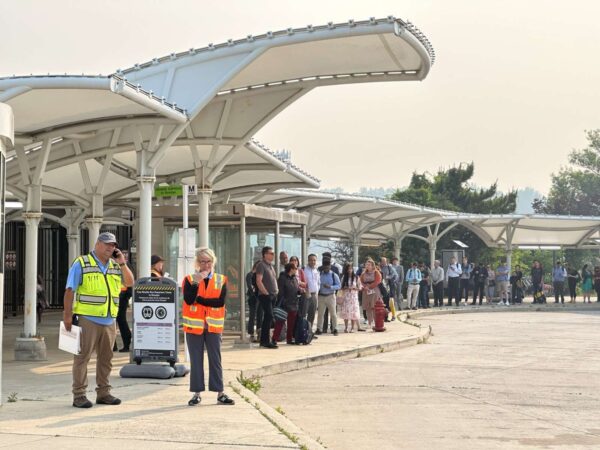
Some good news is on the horizon for local Metrorail riders: the West and East Falls Church stations are set to reopen on Monday (June 26) after a 23-day closure.
The bad news? The Vienna and Dunn Loring stations will remain closed through July 16.
Orange and Silver line service at the four stations ceased on June 3 so Metro crews could replace a 40-year-old steel rail. The transit agency is also using the closures to install fiber optic cables and clear vegetation along or near the train tracks.
After laying down nearly 1,800 tons of rail and removing “more than 42,000 linear feet of trees, bushes, grasses, and invasive vines,” the Washington Metropolitan Area Transit Authority says it will advance to the project’s second phase next week.
“Our team has made great progress on this work so far. As of last week, our team has replaced 15.5 miles of track, installed nearly 36 miles of fiber-optic cable, replaced two diamond interlockings, and installed 13 new switch machines,” Metro Chief of Infrastructure Andy Off said. “They are working to keep the system safe and reliable, and we thank our customers and visitors to the area for their understanding and patience.”
The extended shutdown has been a source of frustration for many commuters in Northern Virginia, despite Metro’s efforts to minimize disruptions by providing free shuttles.
After getting reports of long lines and wait times for the shuttles, particularly at the Vienna and Ballston stations, WMATA said on June 7 that it would add more buses, coordinate with police to ensure free movement through traffic and reevaluate routes through the more congested areas of Rosslyn.
However, the transit agency noted that wait times could still reach 20 minutes during peak rush hours “based on the volume of customers at these stations.”
Some waiting should still be expected at the Vienna, Dunn Loring and West Falls Church stations going forward, Metro says, advising riders “to allow extra time for their travel,” especially during rush hour.
From June 26 through July 16, free shuttles will be provided with stops at those three stations, arriving every 10 to 20 minutes. There will also be an Orange Line Express with service between Vienna and West Falls Church every eight to 15 minutes on weekdays.
Standard buses from Metro and other transit services, including Fairfax Connector, will be available as well: Read More
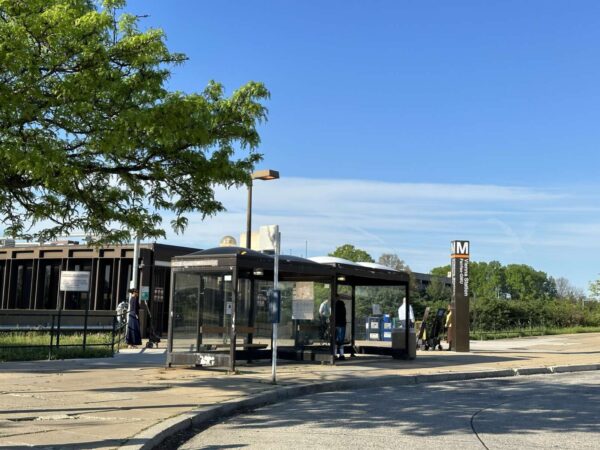
Metro will assemble an armada of shuttles this summer to support travelers during its multi-week shutdowns of several stations on the Orange, Silver and Green lines.
The Washington Metropolitan Area Transit Authority (WMATA) announced yesterday that free shuttle buses will be available throughout the closures, which will begin on May 12 and roll out to Fairfax County’s Orange Line stations starting June 3.
During the closures, the agency will conduct maintenance work at each of the stations and modernize their facilities.
“Continued maintenance work is essential to safe and reliable rail service,” WMATA Chief of Infrastructure Andy Off said in the press release. “We are working strategically to target maintenance locations and minimize the impacts on customers as we conduct this critical work to upgrade systems, improve reliability, and modernize station facilities.”
In Fairfax County, the closures will take place in two phases.
First, the Vienna, Dunn Loring, West Falls Church and East Falls Church stations will close from June 3 to 25 so that Metro can replace the 40-year-old train rails and add fiber-optic cables.
“Replacing the track in this section is a top priority to ensure safety and increase reliability,” WMATA said.
A combination of local, express and limited-stop shuttle service will be offered:
Orange Line Shuttle: Local service between Vienna, Dunn Loring, West Falls Church, East Falls Church, and Ballston-MU stations.
- Local service between McLean, East Falls Church, and Ballston-MU stations.
- Every 5 minutes during rush hours. (6- 9 a.m., 3-7 p.m.)
Orange Line Express: Express service between Vienna and Rosslyn stations.
- Service every 5 minutes during rush hours. (6-9 a.m., 3-7 p.m.)
- Service every 10 minutes during non-rush hours. (9 a.m.-3 p.m., 7-9 p.m.)
Silver Line Limited: Limited-stop service between Washington Dulles International Airport, McLean, and Rosslyn.
- Service every 5 minutes during rush hours. (6-9 a.m., 3-7 p.m.)
- Service every 10 minutes during non-rush hours. (9 a.m.-3 p.m., 7-9 p.m.)
Silver Line riders will need to take a shuttle to bypass the East Falls Church transfer station. Trains between Ashburn and McLean will run every eight minutes, except after 9:30 p.m., when they will operate every 10 minutes.
Both of the Falls Church stations will reopen on June 26, but the Vienna and Dunn Loring stations will stay closed through July 16 to finish the rail replacement and cable installation.
Free local shuttle service will be provided betwen the Vienna, Dunn Loring and West Falls Church stations, operating every 5 to 10 minutes on weekdays and every 10 minutes on weekends while Metrorail is open.
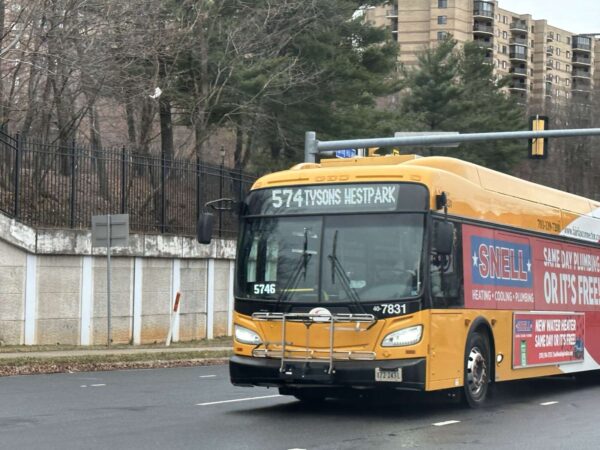
All kids under the age of 12 will soon be able to ride the Fairfax Connector for free.
The Fairfax County Board of Supervisors voted yesterday (Tuesday) to change the bus system’s policy to allow any child 12 or younger to ride for free when accompanied by a paying adult.
The vote closes a gap in the county’s transit policy that left children between ages 5 and 12 paying for bus fare, while younger kids and high school students can ride for free.
Hunter Mill Supervisor Walter Alcorn said the change is part of an ongoing effort to expand the number of riders who can ride Fairfax Connector fare-free — without going fully free like neighboring Alexandria.
“This is a nice step forward,” said Alcorn. “…As we move forward with identifying populations that really should get free fare, we should do that, and just as a reminder, we have some other things coming in terms of reduced fare. So, this is one of a number of initiatives we’re doing in terms of our bus fare strategy.”
Chairman Jeff McKay said one of the long-term benefits of getting more children riding Fairfax Connector is familiarizing a new generation with mass transit.
“This is great,” McKay said. “Not only is it for people who need it — in this case it’s free fare for children — but we’re also building a population and educating a population on how to use mass transit. It’s an investment in the future, and we’ve certainly seen that with the student bus pass program.
Calling the new policy “fantastic,” he thanked county staff for proposing the change and “the speed at which they got this to the Board for approval.”
The new policy will take effect on May 1.
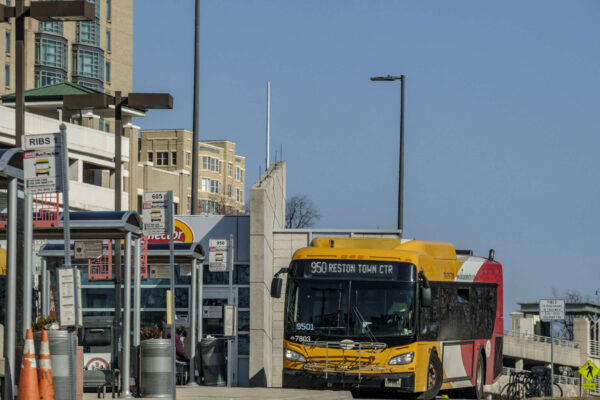
Fairfax Connector could be free for all children ages 12 and under.
The Fairfax County Department of Transportation’s current policy is kids under 5 years old do not need to pay a fare. The new policy would extend that to all children under 12.
Older children can already get a free student bus pass: all Fairfax County middle and high school students can ride on all Fairfax County routes and some Metrobus routes for free between 5 a.m.-10 p.m. with a student bus pass. The transportation department said in a presentation the change would “close a gap” in the county’s fare-free policy for kids.
Those children would still obviously need to be accompanied by a fare-paying adult to receive a free fare.
In a presentation, the Department of Transportation said there are several potential benefits to the change.
- Closes the gap in fare-free travel for children between ages 5-12
- Increases accessibility and removes barriers to travel for parents. Especially beneficial for trips to access medical or social services
- This change will help children become acclimated to using public transit from an early age thereby creating increased transportation alternatives
FCDOT is collecting feedback on the proposed change until next Friday, March 10.
The policy change is scheduled to be presented to the Fairfax County Board of Supervisors on April 11. If approved, it would take effect on April 30.
Fairfax Connector launched a pilot last month allowing low-income riders to get half-price fares.
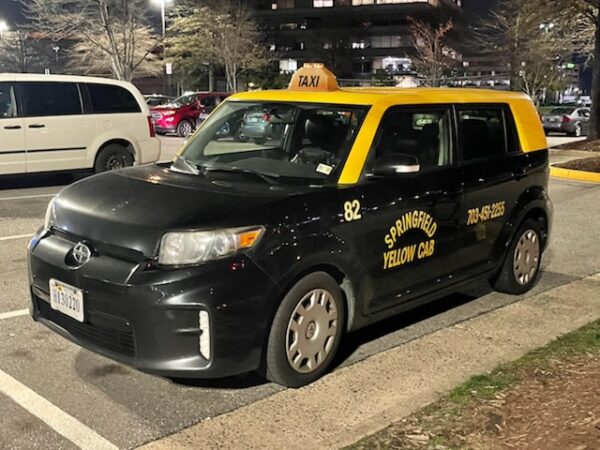
With the rise of ride-hailing services, Fairfax County has seen its taxicab fleet whittled down to just one operator.
That operator, Old Dominion Transportation Group (ODTG), hopes to extend the life of its 130-vehicle fleet by asking the county to revise an existing requirement that phases out taxis once they reach 10 years of age or more than 500,000 miles traveled.
The company has requested that the model-year age be raised to 12 or 15 years and that the mileage limit be eliminated.
“ODTG cites the continued struggle with the effects of the pandemic as well as competition from the transportation network companies (TNCs),” county staff said in a report for the Fairfax County Board of Supervisors. “ODTG also references the different requirements of other surrounding jurisdictions. ODTG believes that it can continue to provide safe, comfortable transportation for their passengers if this request is approved.”
According to county staff, ODTG raised the request on Oct. 11, 2022 after its sole competitor — Alexandria-based White Top Cab — shut down its Fairfax County operations on Sept. 1, returning its 20 taxicab certificates.
ODTG reported that 25 of its vehicles were scheduled to “age out” on Dec. 31, 2022. While it has enough active vehicles to at least temporarily offset the losses, the company says replacing vehicles has become challenging, as the new and used car markets grapple with supply chain issues and fluctuating prices.
Fairfax County and D.C. are the only jurisdictions in the region to impose mileage requirements on their taxi fleets, according to staff.

Following a model already used in Alexandria City and Arlington County, county staff have proposed splitting the requirement into separate tiers for gas-powered and electric or hybrid vehicles:
The 10-year model-age requirement [should] be increased to 12 years for gasoline-only powered non-wheelchair accessible vehicles and 15 years for hybrid, plug-in hybrid, electric, and wheelchair accessible vehicles. This proposal provides an incentive for the operators to replace their fleet with non-gasoline powered vehicles. Staff also recommends that the mileage requirement for all vehicles be eliminated.
The report notes that taxis are required to under go state inspections annually during their first six years of operation. Once they hit seven years of age, they’re also inspected every six months by the county’s taxicab inspector.
“Staff believes these inspections are sufficient in lieu of maintaining a mileage requirement,” staff said.
The staff’s recommended code amendment “balances the challenges of the taxicab operators, considers the practice of local jurisdictions, ensures the safety of the riding public, and helps the environment,” the report says.
The Board of Supervisors will hold a public hearing on the proposal around 3:30 p.m. today (Tuesday).
A new dashboard looking at transit around the region illustrates Fairfax Connector’s slow climb back to pre-pandemic ridership levels.
The Northern Virginia Transportation Commission recently released an interactive website that lets users break down ridership at various local transit services and compare and contrast those figures.
For Fairfax Connector, data from the last year of ridership shows a stark upswing that started in June and has gradually brought the system back up to pre-pandemic levels.
The bus system had a promising start to 2020 with 669,501 riders that January — higher than numbers for that month in previous years. Those numbers dove over the next two months as the Covid pandemic kicked into gear, dropping to a low of 248,866 riders in April.
Ridership only marginally recovered through the rest of 2020 and 2021, but the pace of recovery picked up in 2022 and shot up from June to July, reaching a post-pandemic high of 738,968 riders in August 2022. In September, Fairfax Connector surpassed pre-pandemic ridership for the same month for the first time since February 2020.
The Connector isn’t alone in this recovery. DASH in Alexandria and the CUE bus in the City of Fairfax saw similar recoveries in the second half of 2022.
In Alexandria, DASH’s dramatic uptick in ridership seemed fueled in part by switching to a fare-free system. Fairfax County was considering a similar move for the Connector, but that was tabled by the Board of Supervisors earlier this month in favor of a discounted rate for low-income passengers.
Overall transit ridership in the area, though, remains significantly below pre-pandemic levels — in large part due to Metro accounting for more than 78.6% of the region’s ridership.
Metro didn’t have quite the same dramatic return to pre-pandemic ridership in Virginia that Fairfax Connector experienced.
While Metro’s combined ridership for rail and bus was higher every month in 2022 than it was in 2021, it’s still half what it was in 2018 and 2019. In Virginia, Metro’s ridership for September was roughly 4.1 million — less than half of the 9.2 million riders in 2019.
Fairfax County doesn’t have the same high percentage of access to transit — around 61.3% of the total population — compared to neighbors like Arlington and Alexandria, but that’s to be expected given that it’s significantly larger with less urbanized areas.

